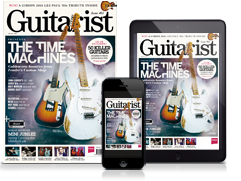Jim Campilongo: Prince of tone
The king of retro-futuristic Tele-twanging talks
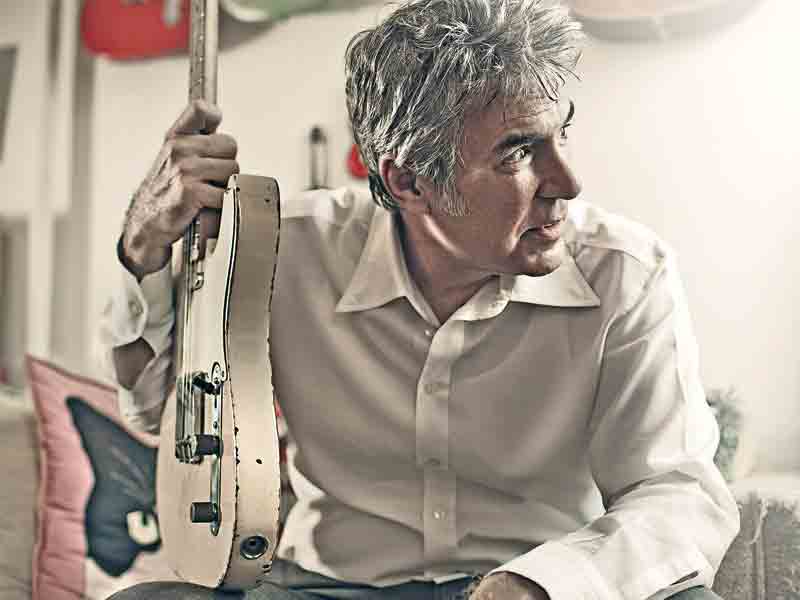
Tastefully on the edge
Few guitarists are more savagely original than Jim Campilongo. His music is a sonic hall-of-mirrors in which blues, jazz and country are warped and magnified into strange new forms with every barbed lick from his ’59 Tele.
Jim’s recorded a string of acclaimed albums and he’s also a first-call session player for top artists such as Norah Jones, while Fender recently honoured him with his own signature-model Telecaster. So we thought it was high time we caught up with Jim to talk about the genius of Roy Buchanan and why Fender’s Princeton combo is the Tele player’s best friend, amongst many other things.
Your latest album, Dream Dictionary, is an essay in tasteful but on-the-edge playing. Tell us about it…
“The reason I recorded it is becauseI played with Josh Dion [drums] and Chris Morrissey [bass] once and it was really good – but the second time we played, it was kind of magic. The third time we played, it was even better and I told the guys, ‘I’m gonna book recording time.’ Like, we’d only played three times together. I just knew it was a great band with chemistry.
“You know, I even said ‘maybe the songs will sound better in a year after we play them. You know, for a year they’ll develop. But if we record now, we’ll catch us in a really special time of growing and listening and exploring.’ And it pretty much worked. It was like the pure discovery of music with nothing sitting on our shoulders and putting pressure on us: no amazing prior performances, like, ‘Jeez, remember thatgig where four beautiful women walked in when we played this song and the room sounded great…’ and so, it was really anice experience.”
You’ve got a really haunting, unusual vibrato – where does that come from?
“One of the revelations I had when I was a very young guitarist, in 1979 or something, and I saw Roy Buchanan play, and I saw that he didn’t use his vibrato. At the time, everybody kind of played with lots of vibrato: players like Eric Clapton and Mike Bloomfield – guys that you’d hear from going just outside the house – I mean, if you remember Bad Company, their guitarist Mick Ralphs… his solos are almost more vibrato than solo.
"So I was still learning, and I kind of had vibrato on auto-pilot, because it sounded like a lot of the music I heard. Then I saw Roy Buchanan and he’d just go… [sings long-sustaining note]. It was like he’d kind of bend slowly in-between this weird semitone and hold it. Because it was so naked and so pure, it was absolutely captivating to me. So that’s when, you know, I started not using vibrato.
“Then I heard Roy Nichols in Merle Haggard’s band. There’s a record I was really influenced by, called Okie From Muskogee, and it’s Merle Haggard live in Muskogee, Oklahoma.
“I started learning stuff off that record, where there is vibrato and bending. The bending was based on how a pedal steel sounds a little bit, where it’s very accurate. So, that influenced me. Then, later on, with The Past Is Looking Brighter And Brighter,I was thinking of a Maria Callas aria. Like, what would she do [with her voice]?”
There's a Chet Atkins vibe to some of your playing, too – do you use hybrid picking?
“Absolutely. I use all the fingers of my right hand. I use my pinkie, my little finger on chords. Unless I’m slamming out a barre chord, I generally pick things like that because I was influenced by steel guitar.I love the way it’s instantaneous and even, you know, you hear all four notes come out at the same time, as opposed to that microsecond it takes for your pick to strum it.”
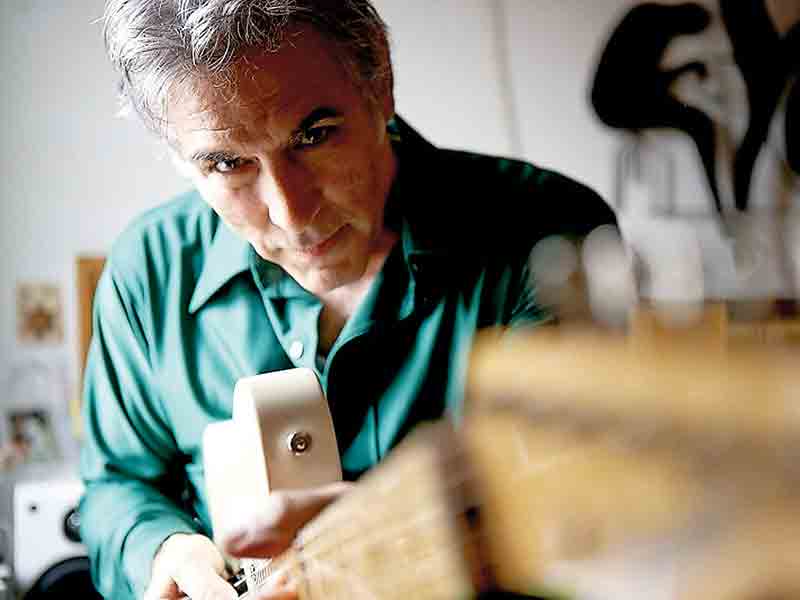
Guitars and amps
Like Roy Buchanan, you’re a fan of Telecasters. What guitars did you take into the studio for Dream Dictionary?
“My ’59 Tele. I played the track Pie Party and some of Nang Nang on my signature model. I really like my signature Tele. I just had the ’59 refretted by the way. It plays really nice.
"For me to get guitars in perfect order, especially living here in New York, because one day it’s 90 degrees and it’s humid; the next day it’s 50 degrees and raining… it really wreaks havoc on the guitars. I mean, it’s one of many things that’s very difficult about living here.
"New York is a great, great American city. In my opinion, it’s the greatest American city. But it’s hard to live here. One of the reasons, aside from rent and everybody bumping into each other, is the weather – it really messes up my guitars.
"I got both those guitars set up and I believe I put different saddles on my ’59. I really make sure that all my equipment just couldn’t be functioning better. So I brought those two guitars in, but I primarily play the ’59.”
How about amps?
“It was all different Fender Princetons:I had a Princeton with a JBL 120 12-inch speaker; I had a Princeton with those gold-back Jensen speakers; I think it’s a C10N.I really love that amp, and I brought that amp but I didn’t use it. I didn’t use anything but one amp, which was a Princeton with a Celestion G10. That’s the only amp I used. Then we re-amped.
“Now the thing is, whenever I’ve played at studios and they go, ‘Yeah, you know we have 40 amps; you’ll have a field day.’ Generally, those are 40 amps that don’t work. By which, I mean they work, but they’re noisy; they have bad pots; the tubes are bad; a speaker rattles. Like, I spray money with a fire hose on to my Princeton that I use in the studio. I put in vintage, you know, new old stock tubes. I bring them to the amp repair guy. I put in a new speaker every six months. If Prince said, ‘I want you to play for me,’ I would feel very happy bringing that amp to that audition.
“Now I have maybe five other amps that I’m not so sure about – I can’t be spraying money into those as well. But I’m talking about, like, a super-high bar. So that’s another reason I just bring a few different amps to a recording session where we have to get everything in two days.
"I want the amps not to buzz; I don’t want them to crackle; I want my speakers to work. I just want to get a great sound. If I get two or three great sounds, hopefully four, I’m happy, like, ‘Okay, great, let’s make a record.’
“Other than that, I also – what’s it called?I re-amp. So I get my channel that I’ve recorded with, and then we run the signal, the output of the guitar channel, through another amp and record that. Place the mics all over the place, to where there’s a sweet spot; and we played through this – what the hell was it? Like a Super Reverb that used to be owned by Buddy Guy.”
Your tone’s pretty chunky. Do you play heavy-gauge strings?
“No, I use D’Addario, nickel 0.009 to 0.042. I’m very grateful that D’Addario gave me a string endorsement 25 years ago. If you think I’m ‘not famous’ now, you should’ve seen how not famous I was 25 years ago! Back then, I really needed it – I wasn’t making much money. They gave me an endorsement, and I burn through strings.”
A lot of the album sounds like in-the-moment improvisation, especially our favourite track, Heaven Is Creepy…
“I’m so happy to have you ask me about that tune. When me and Josh and Chris got together, I mentioned it was kind of magic – well, we discovered our chemistry on that song. The first or second time we played, it was just this great journey, you know: I felt like I got my life’s wish and I could be in Cream or something. We played it a few times, and there was one really good take.
"That one was the best we had ever played it, ever [a previous version of the song appeared on one of Jim’s earlier albums – Ed], and it was in the studio, which rarely happens. It was just absolutely spot-on. So that’s the story behind that track, and I’m really glad you heard how intense it is, and how musical it is. I think it’s really like a conversation between the three of us.”
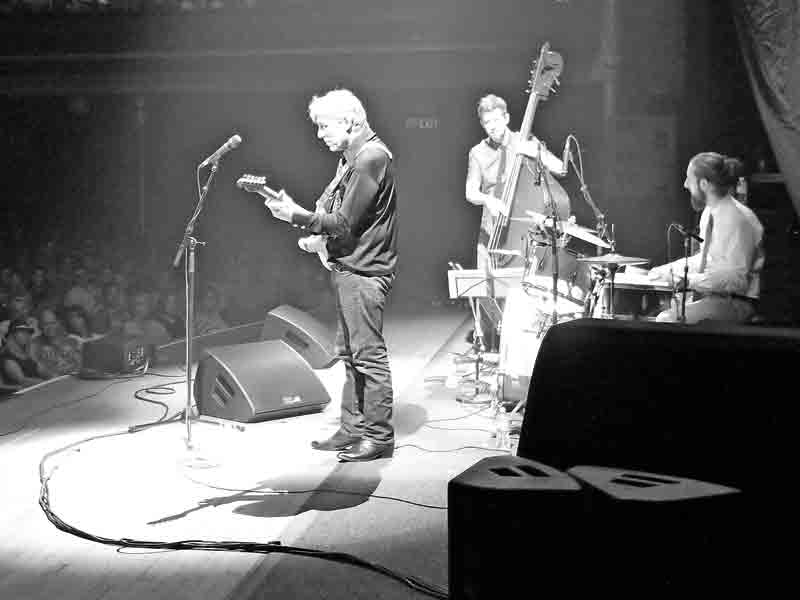
Biting the bullet
How do you get that live, spontaneous vibe in the studio?
“Well, the last couple records I’ve made I haven’t wanted to wear headphones. I just tell the engineer before I work in the studio: ‘I’m going to play loud; I don’t want to wear headphones. I want to be in the same room with everybody. Can you make that work?’ But on my first few records, I would let the engineers dictate my experience. They’d say, ‘You have to do this, you have to do that.’ Like: ‘Let’s put the amp in another room.’ And I’d say, ‘Jeez, I want to be close to it,’ and it’d be, like ‘No’, and I’d kind of agree with it.
“Then, finally, I thought, ‘You know, all that really matters is how comfortable I am.’ I mean, If I love a Thelonious Monk song, it’s not because of some state-of-the-art recording – it’s just a great, exciting musical experience.
"In that regard, whatever I’m gaining in guitar tone by wearing headphones, I don’t feel it’s worth it. So what we did was we just put baffles up – we put plexiglass around Josh, and my amp was, you know, encased a little bit, but you could still hear it.”
Do you ever take a second run at a solo?
“Sometimes you have to bite the bullet. I mean, I could get ‘perfect’ solos if I overdubbed – I could take like five or six tries at it, sitting in the control room. But I wouldn’t enjoy doing that. I did those kind of solos on my two records 10 Gallon Cats and Loose. The solos are really, really tight and no note is wasted. But I found that I didn’t really enjoy listening to them. I don’t hate them, I just never wouldlisten to them. But I do listen to solos on Dream Dictionary – especially Manic Depression and Heaven Is Creepy, I really enjoy it. Maybe there are things I play that I wouldn’t have done [had I taken several passes at it], but it’s really organic. So it does take a bit of bravery to just go, ‘Okay I’m gonna face myself here.’”
Does the pressure of trying to nail a perfect take in one go ever get to you?
“There’s a thing I do when that occurs, and it occurred on Heaven Is Creepy. I knew we had this great take and the thought of, ‘Don’t screw this up, Jim’ entered my head. I have enough experience to think at that point, ‘Get out of here: leave. You’re evicted.’ Then I listen. I listen to the bass and drums and pretty much always think, ‘This sounds good with or without me.’ Then I relax again.”
There’s a lot of early country and blues influences on the album – is that eraa big inspiration?
“Oh, for sure. I really like Roy Nichols, Don Rich, and then in the Buck Owens BandI really like Tom Brumley, the steel player. Going back to guitar, there’s Chet Atkins, Jimmy Bryant, Jimmie Rivers – who was kind of more of a swing player, but he was like a really, really great influence. As far as rockabilly goes, definitely Scotty Moore. So there are many people I’ve really wrenched as much as I can from them. I just think
I love what they’re saying.
“I also love Lonnie Mack. I think Lonnie Mack’s early guitar playing and work is totally underrated. He’d just play kind of like bad-ass blues playing. One of the things
I love about blues that people don’t do enough, is switch from a straight time to a shuffle time. That’s exactly what we do on the track Tony Mason. You know, Willie Nelson’s band does that constantly? And it’s one of the things I love about Muddy Waters and Bo Diddley.
“So if I can play something melodic with that rhythmic sensitivity and organic quality, I’m very, happy and inspired. If I’m playing over, you know [sings clichéd, wailing blues lick], it’s not my thing. It’s just like blues for Coca-Cola commercials.
"I just don’t like that kind of music. I don’t like a lot of what has happened to certain music. There seems to be a lack of space, humanity, humility and love. I think music needs those things very much.
"If I don’t hear space, humility, humanity and love in music, andI just hear, ‘Buy me, buy me, buy me,’ I just don’t want to hear it.”
Dream Dictionary by Jim Campilongo is out now on Blue Hen Records
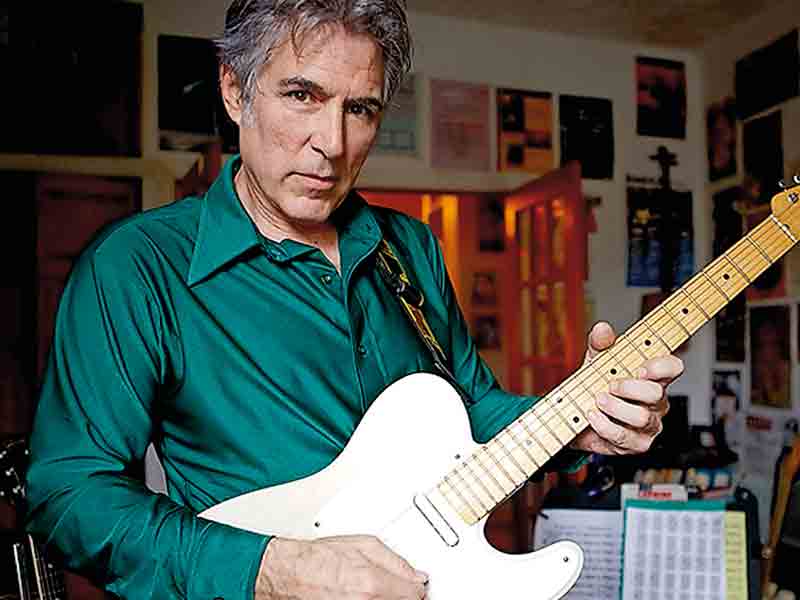
Show & Tele
Jim talks us through the tone tweaks of his modded signature-model Tele…
“I was totally wired that Fender made a Jim Campilongo Telecaster –I still can’t believe it whenI see my name on the back of it. I was totally honoured they made it.
"There were 50 made of the Blonde finish version of my Custom Shop Tele. I’m not a super-huge fan of those kind-of banana yellow Teles [laughs], but some great players use them. Tonally, the signature model is not a great departure from my ’59. It’s a nice sound and I’m really happy with what they did.
"It’s actually easier to play, because the neck of my ’59 is almost scalloped from fretboard wear. But there’s no obstructions on the new ones. It’s a nice neck you can kind of dominate. The guitar is actually very light, too.
“We went through dozens of pickups, and although Fender always sent us really good pickups, I was really particular in wanting something really woody-sounding, really bassy-sounding. On the neck, it’s a nice jazz sound, for a Tele. One of the other features is that it’s really flat on the back of the neck [where it meets the headstock] to make sliding up for behind-the-nut bends easier.
“But the most major feature is the modified bridge. Most Tele bridges have a ‘soap dish’-type lip round the edge of the bridge, and I would always hit that with my pick and it would really annoy me! It’s hard enough to play guitar without having this metal thing keeping you from picking your strings [laughs] – because I pick way back next to the bridge a lot of the time. It gives you a much different sound. So I’d pick there, and inevitably I’d hit that plate.
"So one of the first things I asked was, could we remove that lip? And they were really cool about it. I was worried that in some way I’d miss it – that I might be using it to rest my fingers on without realising it. But that’s not the case. It’s great.
“Finally, it’s got the top-hat switch tip on the pickup selector. I find switching between pickups quickly is problematic with those short little switch tips. So we used a 60s model that you can grab easily when [the pickup selector is in the bridge position].
"The smaller switch-tips kind of hide behind the volume knob. And I find the top-hat type just makes more sense to me. So that’s my Custom guitar!”
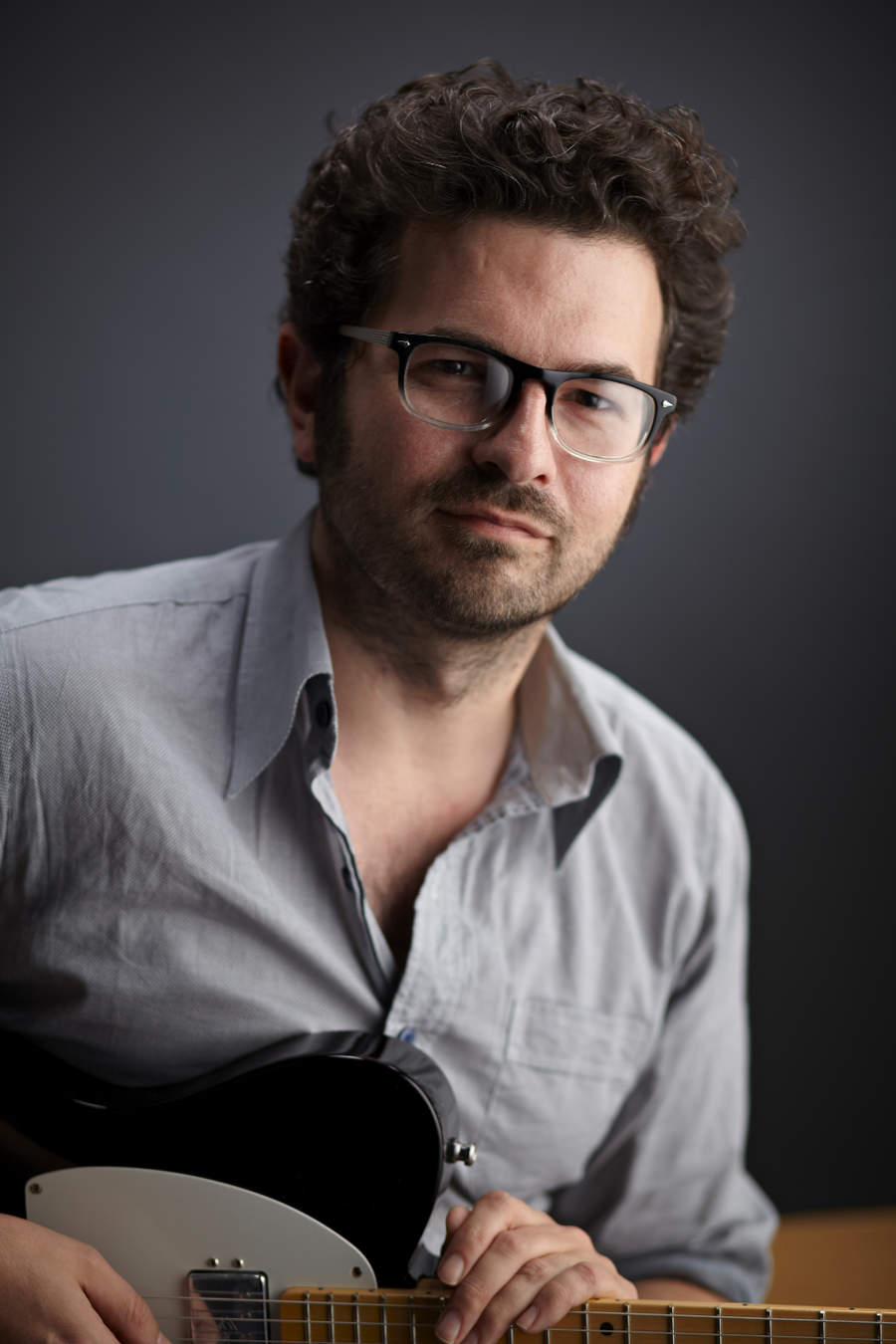
Jamie Dickson is Editor-in-Chief of Guitarist magazine, Britain's best-selling and longest-running monthly for guitar players. He started his career at the Daily Telegraph in London, where his first assignment was interviewing blue-eyed soul legend Robert Palmer, going on to become a full-time author on music, writing for benchmark references such as 1001 Albums You Must Hear Before You Die and Dorling Kindersley's How To Play Guitar Step By Step. He joined Guitarist in 2011 and since then it has been his privilege to interview everyone from B.B. King to St. Vincent for Guitarist's readers, while sharing insights into scores of historic guitars, from Rory Gallagher's '61 Strat to the first Martin D-28 ever made.

